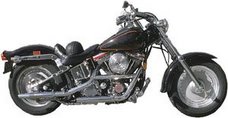Coating a Valve
WHY coat a valve? The purpose behind coating a valve is to extend the part life and reduce friction. You're dealing with an intake valve and an exhaust valve. We'll look at the intake valve first.
The INTAKE valve seals the combustion chamber on the intake port side of the head. Prior to that, it is opening to allow air and fuel to enter the combustion chamber. In take valves usually do not suffer as severely as exhaust valves which see combustion chamber temperatures. Therefore, the primary concern is lubricating the valve stem and seat. We do this by the application of a dry film lubricant such as DFL-1, TLML, or CERMA LUBE. This reduces the friction particularily in engines where oil flow is restricted to the head. The dry film takes over the bulk of the lubrication chore. It is still advisable to coat the face of the valve in the combustion chamber to help retain combustion chamber heat in the chamber. This also reduces the operating temperature of the valve. It reduces the temperature of the back of the valve so the incoming air fuel mix does not pick up as much heat from the valve, as it would, if it were uncoated. Normally, it is not necessary to thermal barrier coat the back of the valve, though, it can be done if you wish. Typically, the face is thermal barrier coated with CBC2 or CBX; the back and stem are dry film coated with DFL-1, TLML or CERMA LUBE.
On the EXHAUST side we have a more severe environment because the valve is seeing combustion chamber temperatures, which on a normally asperated engine, can easily be at 1350F; on certain engines this can run even higher. So we definitely coat the face of the valve with a thermal barrier ( CBC2 or CBX ) to reduce the heat that the valve absorbes. Then coat the back of the stem with a dry film lubricant ( DFL-1, TLML or CERMA LUBE ). Again, it's very critical on the exhaust valve stem because the heat can reduce the ability of your oil to lubricate. Consequently, the permanently bonded, high pressure, high temperature lubricants work extremely well at reducing friction and wear on the valve and the guide. In some cases, it is advisable to coat the back of the exhaust valve such as on a Titanium valve where you can have metal erosion due to hot gas and flame passing over the raw Titanium. ( CBC2 or CBX ). On other valves it is still preferable to coat the back with the dry film ( DFL-1, TLML or CERMA LUBE ) to contribute to carbon shedding so you do not get a carbon build-up on the back of the valve which can create turbulance in the exhaust flow.
Also, by coating the back on both the intake and exhaust valve after all machine work is done, you permanently bond the lubricant to the areas that will contact the valve seat thus reducing wear in this area and creating a better long term seal.
More information can be found at http://www.engineceramics.com/
Friday, June 22, 2007
Subscribe to:
Post Comments (Atom)


No comments:
Post a Comment